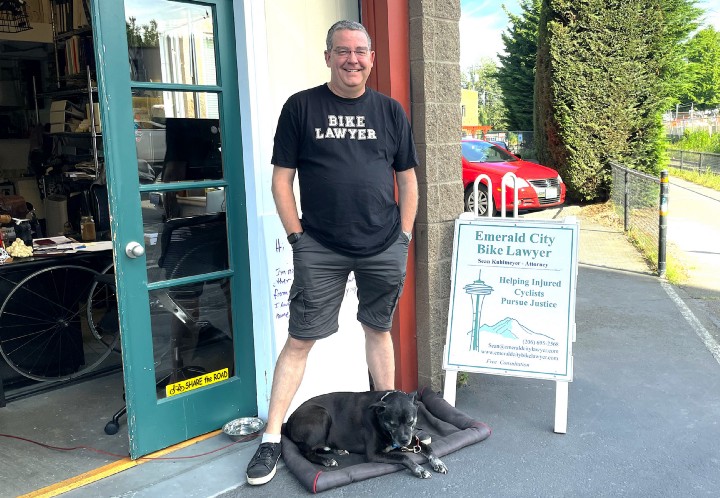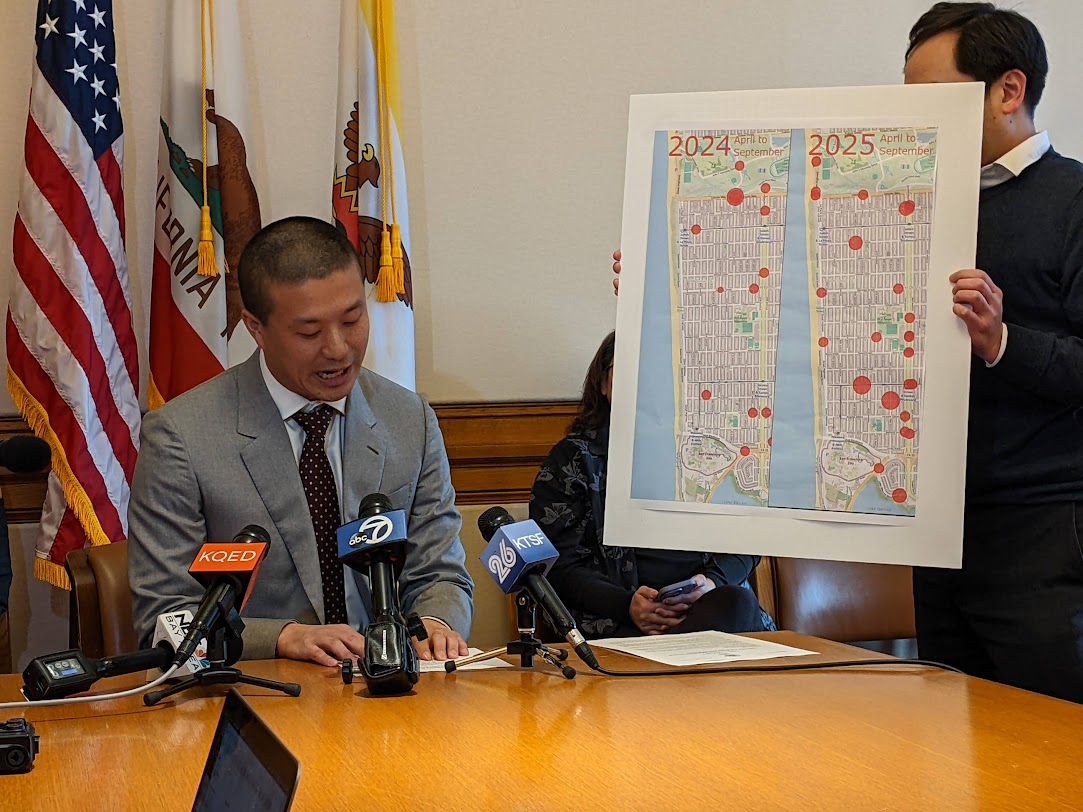This article first appeared in the Frisc and is reprinted with permission.
When San Francisco Mayor London Breed was photographed riding a bicycle in Paris earlier this year, it seemed a favorable omen for SF’s latest climate pledge, made a year ago, to shift 80 percent of all city trips to sustainable transit by 2030.
Bikes will have to make up a big part of that number. As the mayor likely heard on her petit voyage, Paris poured $147 million into its bike network from 2015 to 2020, then recently doubled that number to expand the network by turning its COVID-era slow streets into permanent bike-friendly zones.
Did the mayor get the message? That’s what advocates wondered after her recent intervention to downgrade SF’s slow Lake Street. “It definitely makes us nervous,” Molly Hayden, a steward of different slow street, told The Frisc in July.
SF transit officials promised to present a grand plan to mesh slow streets into the city’s expanding bike network, but the plan, and a big hearing, have been delayed more than once, and now there’s no scheduled date.
Meanwhile, there’s someone else the mayor should meet, and he’s only a two-hour flight away: Sean Kuhlmeyer, a Seattle bike lawyer. That’s Kuhlmeyer’s self-appointed title — he’s got the T-shirts and signage to prove it — but he’s got grimmer artifacts too.
In his small Seattle office, a half dozen bicycles or parts are suspended from the ceiling. None are roadworthy anymore. “This guy got rear-ended by a Harley,” Kuhlmeyer says, pointing to a bent wheel rim that was once on a blue bike.
It’s not just the décor that makes Kuhlmeyer’s practice unique. He also hangs out his shingle — a white sandwich board — on the Emerald City’s busiest bike path. His office door opens onto the 20-mile Burke-Gilman Trail, and — with other businesses like a coffee-and-tuneup shop and a brewpub with ample bike parking — sends a message that San Francisco should heed: Build the infrastructure, make people feel safe, and an alternative to autocentric cities could emerge — even in a city where the weather is downright lousy for biking several months a year.
Kuhlmeyer does some family law, but he makes most of his living from two-wheeled cases, a reminder that the bike life is never going to be 100 percent injury-free.
‘Too young and dumb’
The Burke-Gilman Trail starts in Seattle’s Ballard district, runs roughly east-west through the main University of Washington campus, then heads north toward the suburbs. Kuhlmeyer moved his practice 10 years ago to Ballard, along the trail; his first bike-related case was a rider who slammed into a metal bollard that the city left in the middle of a trail. She hit the ground head first and lost 15 IQ points permanently, says Kuhlmeyer.
In many of his cases representing injured bicyclists, Sean Kuhlmeyer says drivers explain the crash with some variant of ‘they just came out of nowhere.’
They met in a ukulele class, and she said two other attorneys told her she didn’t have a case. Kuhlmeyer took it. “Seattle had immunity from these types of suits, and I was too young and dumb not to know that,” Kuhlmeyer tells The Frisc.
He won anyway.
Seattle has made 80 percent of its COVID slow streets permanent, adding 20 miles of car-free space to its 73 miles of protected bike lanes. The city also has 163 miles of painted bike lanes.
More is on the way. Seattle’s four-year bicycle master plan has funding to add 100 miles of protected bike lanes and push educational campaigns to urge people out of cars.
It’s not all been linear progress, notes Kuhlmeyer, who still battles with the city over bollards in dangerous places — there’s still a pair on the Burke-Gilman Trail near his office, for example. And while the trail follows an abandoned railway, where bikes don’t compete with cars, there are still intersections with roads. Kuhlmeyer, who has biked in Europe but also drives his car around Seattle, says part of the civic education campaign needs to focus on driver awareness. In many of his cases, drivers who injure bicyclists explain the crash with some variant of “they just came out of nowhere.”

Bikes mean business
While San Francisco merchants like these night club owners have worried that bike lanes will block deliveries and hurt their business, Seattle officials are trying to spread the opposite message: “There are many ways to consider the economic benefits of increased levels of bicycling, including major employers — and talented employees — seeing locations with good opportunities for active lifestyles,” the Seattle Department of Transportation says on its bicycle master plan site.
A growing body of research is building an economic case for bicycle infrastructure.
Near Kuhlmeyer’s office is PIM Bikes and Coffee, which has kept a drive-through lane for cars while adding bike parking for pedalers needing a cappuccino break. PIM also offers bike repair, while-you-sip tuneups, and accessories. About a 30-minute ride along the trail is the Burke-Gilman Brewing Company, with bike parking and loaner locks for riders who forget to bring one.
Seattle’s not the only city with suspect weather that’s pushing hard for pedalers. Montreal, where frigid winters have altered pedestrian life, has more than 600 miles of bike lanes and paths. One-third of its bikeways are separated from cars and many allow for two-way bike traffic. It also has rolled out its own nonprofit bikeshare system and has extensive bike parking, including spaces where bikes can be parked in a stacking fashion.
Granted, San Francisco is doing better than many U.S. cities. The Municipal Transportation Agency says it has laid down hundreds of miles of bike lanes. Of those, 42 are protected from cars, all laid down in the last seven years. A new 20-MPH speed limit for cars is also the rule on several of the city’s most dangerous streets. But there is still a major gap between what the city has and what it has promised. Fifty years ago, it was a pledge to be “transit first.” More recently, the city has set goals for street safety and greenhouse gas emissions.
As SF redesigns its streets, it must rethink road surfaces too. Simply adding speed bumps (or humps) to slow cars down might not be enough, as this cautionary tale on Clay Street shows.
The heavily used Wiggle bike route through the Lower Haight now has Wiggle Bicycles (not to mention its own jingle), but it isn’t car-free, and there’s nothing yet like Burke-Gilman in San Francisco. Anecdotally, slow streets have encouraged a few businesses, however, like the Noe Cafe’s outdoor sprawl at Sanchez and 26th Streets, and a pop-up outdoor gym on Page Street that asks regulars for sliding-scale contributions.

To shift its mindset and streetscape, however, San Francisco also needs to emulate the leadership of mayors Anne Hidalgo of Paris and Valerie LaPlante of Montreal, who were both re-elected after promising more for two wheels, and other European politicians are pedaling hard in that direction.
In July, Mayor Breed posted a “what’s next for slow streets” manifesto. But in practice she’s sent mixed signals about those streets, and the door has remained open for a pro-car backlash. Until her team rolls out details of their future vision, it’s unclear how much momentum SF’s bikers, pedestrians, and others ready to get out of their cars will have in the near future.
Kristi Coale is a staff writer for The Frisc, covering transit, streets, and more.






